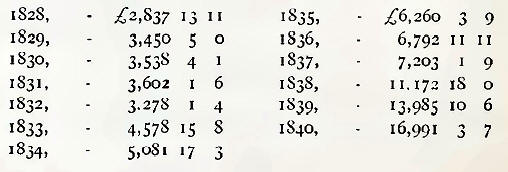|
THE Act was obtained in
1824, the capital being £86,000, and the line was opened in 1826. It was
originally only a single line throughout, with convenient passing
places; the first rails being fish bellied, twenty-eight lbs. per yard,
for horse haulage, and the trade for three or four years was very small.
The line was afterwards
doubled where the traffic required it; heavy rails substituted ; and
locomotive engines for haulage, instead of horses. The first locomotive,
said to be the first run in Scotland, was started on 10th May, 1831.
It was built by Messrs.
Murdoch & Aitken, Hill Street, Glasgow, and was the pioneer locomotive
made in Glasgow. The sleepers were whinstone blocks, and in these early
days of railway making, the engineer had not experience to guide him;
the idea of laying on ballast never occurred to him.
The whinstone blocks
being placed only on the bare earth; when the traffic came, and the
weather became wet; it was no uncommon sight to see the muddy water
spurting up from underneath the sleepers. The consequence was, that the
rails and sleepers had to be lifted off, ballast laid down, and the line
again formed- this being another of the "premiums paid to experience." A
good and commodious basin was formed at the canal at Kirkintilloch.
The length of the line
from Palace Craig to Kirkintilloch is ten and a half miles; a branch to
eastern terminus, at its junction with Ballochney railway, is two miles,
or twelve and a half; traversing Old and New Monkland, Cadder and
Kirkintilloch parishes. Ere long. however, it was connected with the
Garnkirk and Glasgow railway to the west; the Ballochney railway to the
east; the'Vishaw and Coltness railway and Monkland canal to the south;
and the Forth and Clyde canal to the north-west. All these railways and
canals now belong to the North British and Caledonian Railway Companies.
The opening of this Monkland and Kirkintilloch railway gave an immediate
impetus to the development of minerals along its route; and many
proprietors of barren acres became rich- the town of Coat bridge was
also by its means stimulated, in the early growth of that prosperity
which it has since attained.
It has been a successful
line, as may be seen from the increasing revenue, viz.-

|

